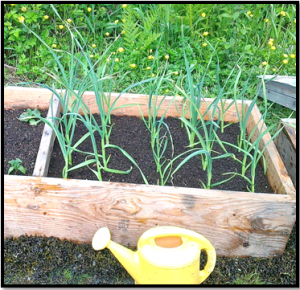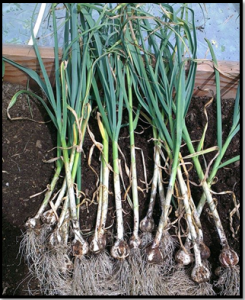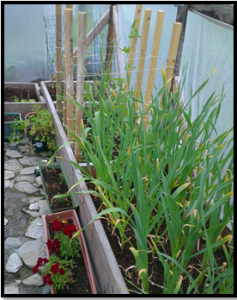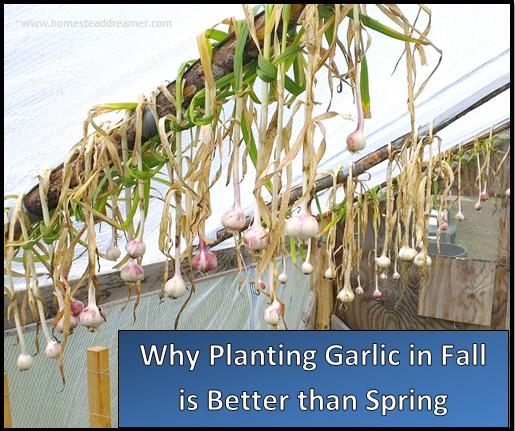We LOVE garlic. No, I mean we love it so much that it is put into just about every meal we eat including breakfast. Roasted, granulated, fresh, pickled, and powdered; we use it all! When I began the first garden last year, I knew we had to grow our own and was thrilled to learn that it grows very well here in our wet, cooler climate. Last year (the first), I planted in Spring. At the end of the season after harvest, I planted in Fall. The following are my own experiences of growing garlic in USDA Zone 7b.
Spring Planting
 We built our coldframes in March and April of 2013. The first one was topped by an old window in a frame that was given to us. I planted some lettuce in there and we were off! I was in love and wanted more. We built another one 8′ x 2′ with a nice quonset style, plastic covered lid. We used PVC pipe for the frame. I sectioned the box and in the largest space is where I planted the garlic, pictured at left.
We built our coldframes in March and April of 2013. The first one was topped by an old window in a frame that was given to us. I planted some lettuce in there and we were off! I was in love and wanted more. We built another one 8′ x 2′ with a nice quonset style, plastic covered lid. We used PVC pipe for the frame. I sectioned the box and in the largest space is where I planted the garlic, pictured at left.
I bought garlic from the grocery store to plant. I just couldn’t wait to start planting garlic! Looking back, I cringe at the thought of doing it again but, you live and learn. As you can see, it did very well even having been bought at the store with deep, rich green colored leaves and strong stocks. I learned about garlic scapes but didn’t see any coming up at all so thought I had bought the softneck variety. Hardneck varieties produce the scapes that are delicious but if left to flower, will produce seed. Most people, myself included, cut the scapes and eat them as they are delicious! Most people simply plant a clove of garlic to grow another bulb as it is easier than getting actual seed (and it takes less time to grow, too).
 The results were decent enough and for my first go at growing anything, let alone garlic, I was thrilled to harvest and cure fresh garlic. I did make some rookie mistakes, though. I did not trim off the roots for starters. I also stored them in a place that was a bit too warm so by the end of Winter, what was left was completely dried out and unusable. After curing, the bulbs were small and the cloves were a test of patience when it came to peeling them because of the size. Some days, the garlic won and I used less than I would normally have. Though small, I was still proud to call myself a successful gardener for at least one plant. 🙂 Of course, I wanted to grow more and get better results. My hopes were pinned on the garlic I planted in Fall.
The results were decent enough and for my first go at growing anything, let alone garlic, I was thrilled to harvest and cure fresh garlic. I did make some rookie mistakes, though. I did not trim off the roots for starters. I also stored them in a place that was a bit too warm so by the end of Winter, what was left was completely dried out and unusable. After curing, the bulbs were small and the cloves were a test of patience when it came to peeling them because of the size. Some days, the garlic won and I used less than I would normally have. Though small, I was still proud to call myself a successful gardener for at least one plant. 🙂 Of course, I wanted to grow more and get better results. My hopes were pinned on the garlic I planted in Fall.
Fall Planting
 So when Fall planting came around, I wanted to do whatever I could to increase my harvest. I decided that being inside the greenhouse would be better for them (I was wrong!) and planting them in Fall would, by all accounts, yield larger bulbs. For seed, I was sent some elephant garlic from some family who live on Vashon Island in Washington State and they grow their own, too. I planted 4 cloves (which were enormous!) in a row at once side of the larger raised bed and the rest was garlic grown on the island by a lady who has been growing her own for the last 15+ years. It is the hardneck variety I was looking for and I knew it was 100% non GMO and all organic. I happily paid $5 a bulb to have enough to plant and some to eat.
So when Fall planting came around, I wanted to do whatever I could to increase my harvest. I decided that being inside the greenhouse would be better for them (I was wrong!) and planting them in Fall would, by all accounts, yield larger bulbs. For seed, I was sent some elephant garlic from some family who live on Vashon Island in Washington State and they grow their own, too. I planted 4 cloves (which were enormous!) in a row at once side of the larger raised bed and the rest was garlic grown on the island by a lady who has been growing her own for the last 15+ years. It is the hardneck variety I was looking for and I knew it was 100% non GMO and all organic. I happily paid $5 a bulb to have enough to plant and some to eat.
We had an insanely warm January this year, while everyone else in the lower 48 was dealing with the ‘polar vortex’ cold. I will not lie, we did have a bit of a chuckle as we were outside in 50 degree weather in shorts around a grill. (Don’t judge me, you know you would be doing the same!)
During that warm spell, the garlic sprouted up. I was worried that when it got cold again they would be killed off. We put some plastic over the top of the bed as by then the snows had already broken the pvc pipe that was used for roofing. Yeah, I know. Live and learn. They managed to make it through all the way but we did run into some problems. First, garlic prefer the cooler temperatures. They absolutely thrive here in 55-75 which is our typical summer temps. Since I had them inside, the temperatures get up to 90+ when it is 75 outside. We have screened ventilation windows in place but nothing to really push the air around.
As a result, the leaves began to really dry out and the deep green began to fade. The door to the greenhouse has been cut in half so we can keep critters out but allow more air to move and I think that is what saved them from not completely dying off. They produced beautiful scapes that were delicious and we still have some in the freezer to enjoy later on. I was thinking about putting some in a pickle batch, too.
Another issue we had was as the leaves dried, it would rain and then heat up and rain, etc. This caused some mold or fungus issues on them but since we already discovered blight on the tomatoes (that is a whole new post itself), I just tried to remove as many dried out leaves as I could to encourage new ones to grow. They were overheated too often and did not truly reach their potential. I mentally kicked myself more than once as I was trying to save them short of cutting the plastic off that section of greenhouse and that would have let the legions of slugs right in so I made do as best as I could. If I would have put a small outdoor fan in there, it would have made a huge difference.
In the end, we harvested 42 bulbs of garlic last week and they are curing in the greenhouse (pictured above) until we bring them inside to finish. Even with all of the complications, they are larger, stronger flavored, and have a much thicker protective skin around them than the ones planted in Spring had. I will be planting garlic in the Fall every year from here on out and have learned some valuable lessons. Thankfully none of the lessons cost me the whole crop! I am confident that had I planted them in the cold-frame like I did the first year, they would be at least half again as large, if not double in size.
Not that I am complaining, mind you. 😉





Hi, I started planting garlic 6 yrs ago as a experiment, not knowing a thing about it, and now enjoy my harvest greatly. look forward to it. I have learned much mostly that it is the easiest thing to plant and grow. As long as you keep it mulched in the fall after planting there isn’t much that it won’t survive. I enjoy the “purple skinnned” breed, not sure of its latin name, but it is very hardy and very tasty, has a peppery flavor.
Love your posts
Thank you so much for the comment Ericka! I fully agree, it is one of the easiest plants to grow with minimal effort. My favorite part is you only need a few bulbs to plant a whole new crop!
So what exactly do you do to start garlic ? Just plant a whole bulb or does it have to be a certain kind of bulb? Thank you for your help I am interested in trying this too
There are many ways to plant. I have heard some people planting whole bulbs and then in spring when they come up, they dig em up to separate the starts and replant. For us, we simply planted one clove in each space about 2 inches deep and let nature take its course! Thank you for the comment and the question!
Where do you cure garlic if you don’t have a greenhouse and how do you know when it’s time to finish them off inside? (I can’t wait for the tomato blight post!!)
You don’t need a greenhouse to dry and cure them. Any dry area with good air flow will work!
Garlic is one of those great plants that will let you know when it’s time. The leaves begin to turn yellow and curl, the stalk begins to slump over, and the whole plant looks like it’s just giving up trying to be green. If you plant in Fall, you will harvest in early Summer (depending on your Zone of course). I hope this helps!